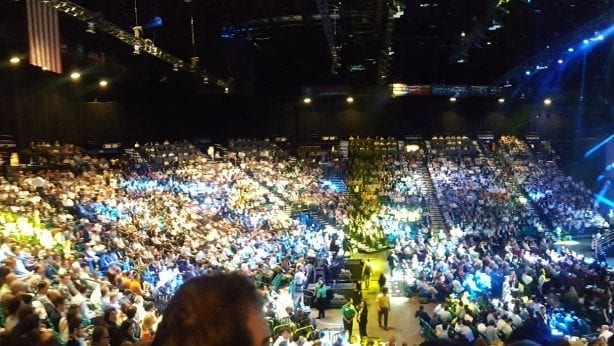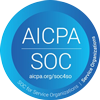A number of us here at Rulesware have been attending Pegaworld conferences since the start, and we’re delighted to report that the 2018 vintage was superb. Pegaworld is the annual user conference for Pegasystems, this year featuring 12 keynotes, 5,000+ attendees, hundreds of sessions and presentation, and — of course — an annually held chess tournament.
It was fantastic.
Below we’ve included a few of our session summaries, with links to videos of the sessions.
Our personal highlight, though, was having the chance to engage with our clients, and with current and past colleagues and friends. Here’s one of our favourite reports on the camaraderie the conference offered:
Pegaworld offered us all such a great opportunity to visit, enjoy each other’s company, and get to know each other even better. We met nightly for dinner with everyone from Rulesware, [CEO Anthony Lee] challenging us all not to talk only of work-related topics. One of my favorite moments came when sharing [with colleagues] two things: something that each of us has always wanted to do or experience but hasn’t been able to yet; and one of the most amazing experiences of our lives. For [one of our team members from El Salvador], hers was traveling to Las Vegas for PegaWorld! It was so nice to get to know each other better in moments like this.
And the icing on the cake: receiving a Partner award from Pega for Implementation Quality.
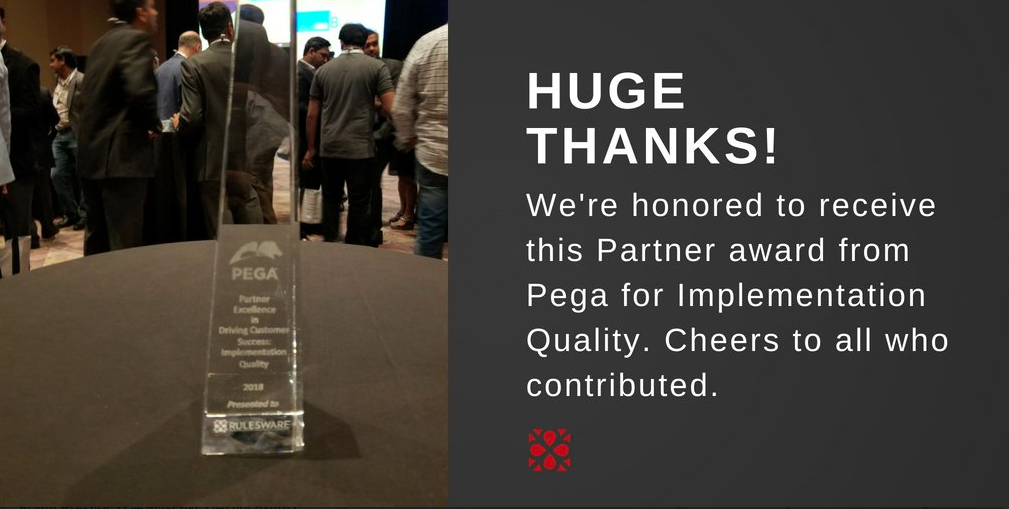
Enjoy the summaries — and please get in touch with your own insights on Pegaworld. We’ll see you next year!
From Digital Chaos to Digital Transformation
In the opening keynote from Pegasystems CEO and Founder Alan Trefler (watch the video here), we were presented with specific examples of how organizations have done Digital Transformation right, and where they’ve gone wrong.
A few of our takeaways:
- Pega is focusing its AI efforts on helping the customer to get the real value (hype vs ‘get real’).
- The new concept of “Minimum Loveable Product” means that the product should always be loved by the customer. It’s a customer-centric concept, where each interaction is personalized, and human.
- We heard from Trefler that business processes are multidimensional: even though a process may have a fixed set of steps, he noted that those steps can present variability, which is tackled by Pega with a “situational layer cake” ™ that helps to simplify and manage this variability.
- A new methodology, Pega Catalyst, uses journeys, personas, data/infrastructure to get the MLP by implementing an architecture that ensures the use of the same “situational layer cake” ™.
- Pega is focusing on on decreasing the complexity of the software stack, and increasing the speed in development by allowing the engineers to design the software—not programming it. Pega says it codes “the software that writes your software ™”.
- Pega allows consolidation of channels in a real omnichannel approach, with intelligence (the brain) with and a full process automation (the actioner), that’s accomplished through using features such as Pega Platform itself, Robot Automation, Decision Hub and others.
- The key points for Pega Catalyst:
- Customer Journeys: Need to focus on meaningful interactions for the client focused on the outputs not the tasks.
- Design thinking
- Agile Methodology
- Alan Trefler introduced the Pega DX architecture (you can check out the Twitter announcement here) which is the combination of all the other points–see below for captures of Trefler’s slides.
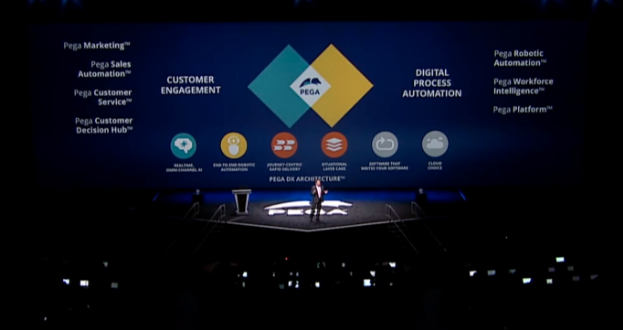
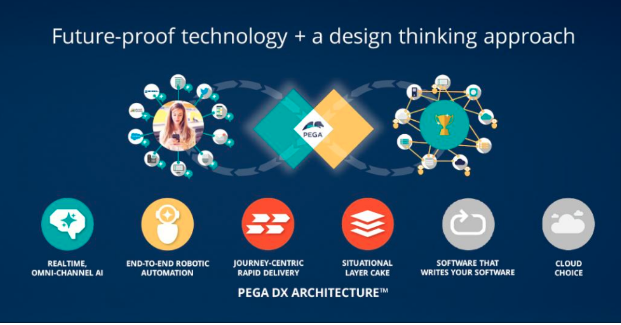
Engage, Automate, and Build – without Limits
Pega’s Senior Vice President of Products, Kerim Akgonul (watch the video here), presented on the new Pega Infinity, the next version of the Pega Platform which is AI-enabled, and sports new features such as self-optimizing sales or best next moment.
Akgonul presented features including:
- New four studios (new versions of Dev and Pega Express among them) including:
- App studio: A new version of Pega Express with graphic visualisation of the apps integrations, see the journeys and the situational layer cake ®
- Dev Studio: A new version of the old Dev explorer with new features such as:
- Robot connectors to allows a Data Page to integrate legacy system by using a robot automation
- Graphic integration maps to simplify the mapping of rest web services:
- New testing capabilities for scenario testing and not only unit testing
- Predictive Studio: New studio for data scientist to create and review prediction models
- Admin Studio: Studio for system administrator allows to manage multiple application instances on different environments, giving visibility to the DevOps pipeline
- Sales Coach: a tool that helps to coach sales representatives through AIs that (who?) can predict the future behavior based on their interactions in sales management.
- Next-Best Moment. With Infinity, a new concept has been added: with the help of AI, the best time (moment) to offer a action to a customer is the evolution of Next Best Action.
- T-Switch: This is a feature that will allow to view the data parameters of the AI that are drivers in its learning, making a normally ‘black box’ behavior visible to the engineers.
- Mailboth and Virtual Assistant: An AI feature and Portal for analyzing unstructured text received by email. It allows the user to retrieve meaningful information that might be used for start actions to accomplish the customer request, such as automatically starting a return product case.
- More integration with bots, allowing Pega Platform to provide truly end-to-end automations.
Open Without Limits: Growing the Pega Ecosystem
Pega Head of Mobile Technology Stephanie Louis (video here) spoke about some of Pega’s changes and innovations designed to help users learn new skills and evolve careers in Pega. A few of our takeaways:
- We’ll see more native components in the mobile landscape that allow Customer-grade applications.
- Louis acknowledged the difficulty in developing Pega-certified engineers, discussing Pega’s ‘university’ programs designed to create an ecosystem of qualified Pega technologists. (Our note: this is something we do internally at Rulesware, too, putting us ahead of the game!)
- Pega is making strides in creating cases and UI by using natural voice and image recognition.
- There’s been a rebrand of PDN to Pega Community, which adds new sections such as the Launchpad: a starting point for 9 different missions including optimizing robotics and using AI to make real time decisions.

